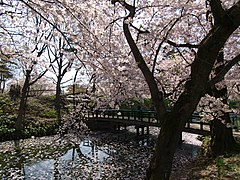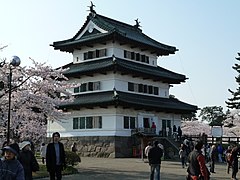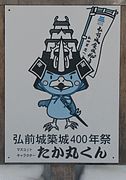Hirosaki Castle
| Hirosaki-jō | ||
|---|---|---|
|
Hirosaki Castle Tower, outside |
||
| Alternative name (s): | Takaoka-jō | |
| Creation time : | 1597 | |
| Castle type : | Hirayamajiro (hill castle) | |
| Conservation status: | Castle tower, watchtowers, gates, walls and moat (partially) preserved | |
| Construction: | Stone, wood | |
| Place: | Hirosaki | |
| Geographical location | 40 ° 36 '26.6 " N , 140 ° 27' 50.9" E | |
|
|
||
The Hirosaki Castle ( Japanese 弘前城 , Hirosaki-jō ), and Castle Takaoka ( 鷹岡城 , Takaoka-jō ) is a Japanese castle in Hirosaki in Aomori Prefecture in Japan .
history
Tsugaru Tamenobu (津 軽 為 信; 1550–1608) managed to break free from the rule of the Nambu and to take possession of the Tsugaru area. The actual construction of the castle in Hirosaki began under his son Tsugaru Nobuhira (津 軽 信 枚; 1586–1631) in the period 1610 to 1611. An extensive castle with a high castle tower, eight watchtowers and ten gates was built. Material from earlier castles such as Horikoshi Castle (堀 越 城, Horikoshi-jō) was used. Part of it fell victim to a lightning strike in 1627. Under the fourth boss of the house, Tsugaru Nobumasa (津 軽 信 政; 1646–1710), Hirosaki received its present form as a castle town between 1661 and 1673.
The attachment
The castle is divided into three main areas staggered in height: From bottom to top, these are the third castle area (三 の 丸, San-no-maru; C), the second castle area (二 の 丸, Ni-no-maru; B) and the inner one Castle area (本 丸, Hommaru; A). In front of the lowest area are the fourth castle area (四 の 丸, Yon-no-maru; D) in the north and the west castle area (西 の 丸, Nishi-no-maru; E). The second castle area is supplemented in the north by the inner north area (内 北 門 Uchikita-no-maru; F).
In addition to the castle tower (天 守, Tenshu; red), there are a number of watchtowers (櫓, Yagura) to protect the castle. The second castle area is protected in the northeast by the northeast watchtower (丑 寅 櫓, Ushitora; 1) and in the south by the southeast watchtower (辰 巳 櫓, Tatsumi-yagura; 2) and the southwest watchtower (未 申 櫓, Hitsumisaru-yagura ; 3). The castle tower and these three preserved watchtowers are registered as an important cultural asset of Japan .
Gates: You enter the castle through the south gate (南門, Minami-mon; a), through the east gate (東門, Higashi-mon; c) or in the north through the "turtle shell gate" (亀 甲 門, Kikkō-mon; e) and thus reaches the lowest, the third castle area. You can continue through the inner south gate (南 内 門, Minami-uchimon; b) or through the inner east gate (東 内 門, Higashi-uchimon; d) to the second castle area. All of the gates mentioned are also important cultural assets.
There are still three bridges to be mentioned: The moat in front of the inner south gate to the second castle area is bridged by the large sickle-fir bridge (杉 の 大橋, Sugi no ōhashi). From the second to the innermost part of the castle you get to the south over the Gejō Bridge (下乗 橋): that means, from here you have to walk. The bridge in the north to the innermost part of the castle is called Falcon Hill Bridge (鷹 丘 橋, Takaoka-hashi).
The innermost district, the Hommaru, is completely protected by high stone walls and a moat. The other castle areas, Ni-no-maru, San-no-maru, Kita-no-maru, were protected by earth walls and moats. Wide moats were created especially on the west side. In the south, a temple city was built around the temple Chōshō-ji (長勝 寺), which had a protective function for the castle. In place of the castle tower that was lost in 1627, the watchtower located there on the southeast corner of the Hommaru was built as a replacement in 1810, with a simple facade on the inside being content. This castle tower is one of the twelve surviving castle towers from the Edo period .
The Tsugaru ruled their domain uninterruptedly until the Meiji Restoration and were among the larger princes with 100,000 koku income. The strait of the sea between the Japanese main island of Honshū and Hokkaidō is named after the family : the Tsugaru Strait .
The castle complex was opened to the public as a park in 1895. The multilevel ramparts and the bank areas are famous for their cherry blossoms - there are said to be around 5000 trees.
photos
Remarks
- ↑ The names indicate the cardinal points according to the 12 branches of the earth .
- ↑ It is the red bridge that you always see in photos together with the castle tower.
- ↑ The poster advertises with the mascot "Knappe Takamaru" (た か 丸 く ん).
literature
- Mizoguchi, Masafumi: Hirosaki-jo. In: Masayuki Miura (ed.): Shiro to jinya. Saikoku-hen. Gakken, 2006, ISBN 4-05-604379-5 .
- 全国 城郭 管理者 協会 : 城 の し お り , (Association of Castle Administrations : Bookmarks of Castles ), 2005.
- Nishigaya, Yasuhiro (Ed.): Hirosaki-jo In: Nihon meijo zukan, Rikogaku-sha, 1993. ISBN 4-8445-3017-8 .






